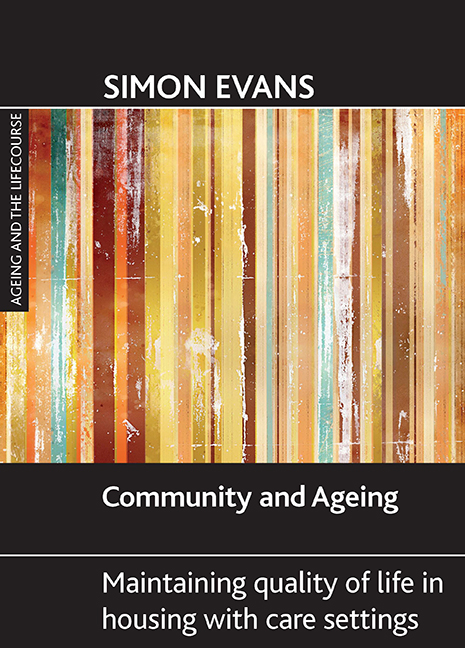Book contents
- Frontmatter
- Contents
- List of tables, boxes and photos
- Acknowledgements
- Foreword
- one Introduction
- two What is community?
- three Community and ageing
- four Housing with care communities in the UK
- five An international perspective on retirement villages
- six Promoting a sense of community in housing with care settings
- seven Diversity, community and social interaction
- eight Changing communities and older people
- nine Conclusion
- Appendix
- References
- Index
- Frontmatter
- Contents
- List of tables, boxes and photos
- Acknowledgements
- Foreword
- one Introduction
- two What is community?
- three Community and ageing
- four Housing with care communities in the UK
- five An international perspective on retirement villages
- six Promoting a sense of community in housing with care settings
- seven Diversity, community and social interaction
- eight Changing communities and older people
- nine Conclusion
- Appendix
- References
- Index
Summary
Introduction
Since the last decade of the 20th century there has been a transformation of the UK retirement housing sector. This is due to a range of factors, including the ageing of the population, increased wealth, greater social mobility and the emergence of an increasingly long post-retirement period, often referred to as the ‘third age’. It has also been widely observed that people's expectations for later life have changed considerably, leading to aspirations for a more active and leisure-based retirement lifestyle. Many older people have seen their housing environment as an important element in achieving these goals. As a result, two particular forms of housing for later life have become extremely popular: retirement villages and extra care housing.
The popularity of these two forms of ‘housing with care’ also reflects the government's focus on supporting independence for older people in their own homes, in settings where flexible care packages are also available. In this respect these two forms of provision are widely perceived as providing a domestic environment, in contrast to the more institutionalised setting of care homes. This has led to these settings being described as a ‘third way’, between living in the community and in residential care. Further reasons for their popularity include the unsuitability of much general housing for older people and a feeling among many retired people that society is increasingly failing to take account of their needs and preferences. This has led to a focus on these two forms of housing with care as ‘communities’ that have been designed specifically and exclusively for older people. This is reflected in marketing campaigns that portray them as places in which residents can enjoy a worry-free later life, doing the things they enjoy with ‘like-minded’ people.
In this book I explore the characteristics of extra care housing and retirement villages, and chart their development in the UK, the US and around the world. I also discuss their role in promoting quality of life for older people and the extent to which they are experienced as communities by those who live in them. These issues are explored in the context of theories of community and ageing, particularly in relation to the built environment and social interaction.
- Type
- Chapter
- Information
- Community and AgeingMaintaining Quality of Life in Housing with Care Settings, pp. 1 - 6Publisher: Bristol University PressPrint publication year: 2009

